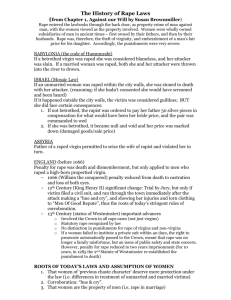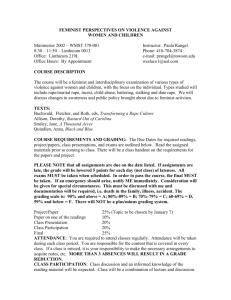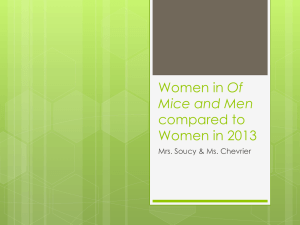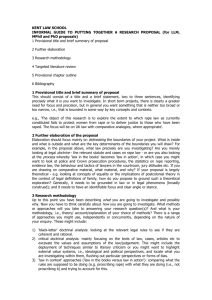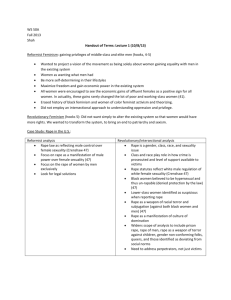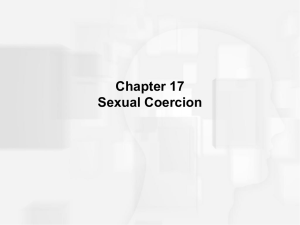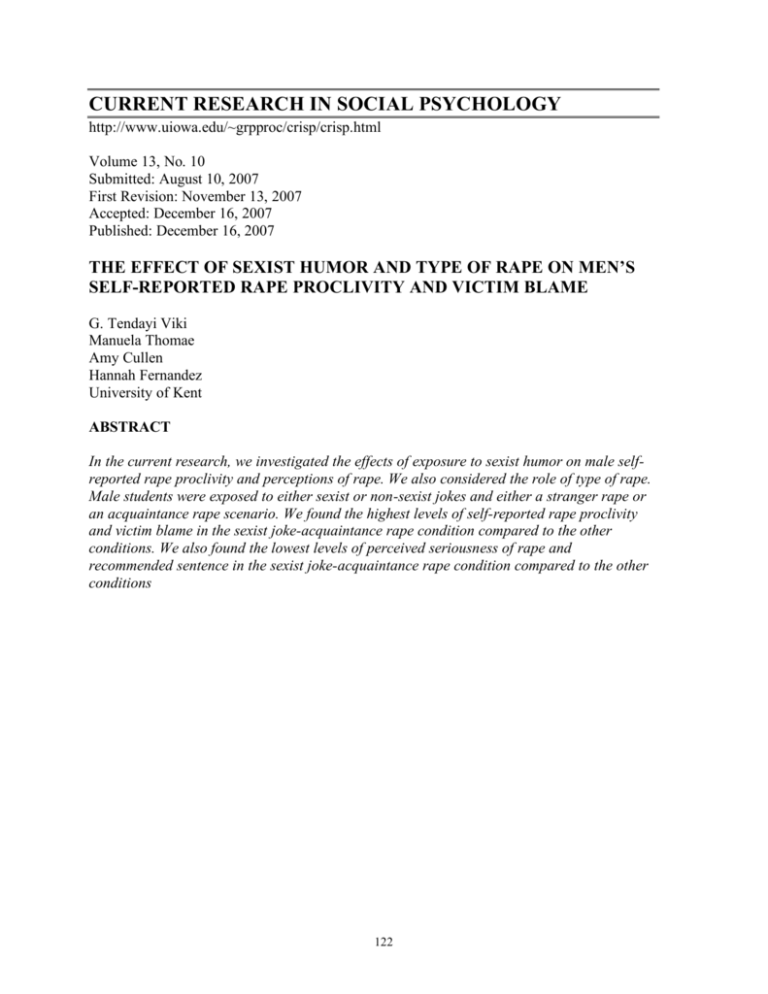
CURRENT RESEARCH IN SOCIAL PSYCHOLOGY
http://www.uiowa.edu/~grpproc/crisp/crisp.html
Volume 13, No. 10
Submitted: August 10, 2007
First Revision: November 13, 2007
Accepted: December 16, 2007
Published: December 16, 2007
THE EFFECT OF SEXIST HUMOR AND TYPE OF RAPE ON MEN’S
SELF-REPORTED RAPE PROCLIVITY AND VICTIM BLAME
G. Tendayi Viki
Manuela Thomae
Amy Cullen
Hannah Fernandez
University of Kent
ABSTRACT
In the current research, we investigated the effects of exposure to sexist humor on male selfreported rape proclivity and perceptions of rape. We also considered the role of type of rape.
Male students were exposed to either sexist or non-sexist jokes and either a stranger rape or
an acquaintance rape scenario. We found the highest levels of self-reported rape proclivity
and victim blame in the sexist joke-acquaintance rape condition compared to the other
conditions. We also found the lowest levels of perceived seriousness of rape and
recommended sentence in the sexist joke-acquaintance rape condition compared to the other
conditions
122
Current Research in Social Psychology (Vol. 13, No. 10)
(Viki et al.)
INTRODUCTION
Sexual violence has been shown to have negative effects on women’s psychological and social
lives (Day, 1995). Surprisingly, research has also shown that a number of men report some
proclivity towards committing rape (Malamuth, 1981). These findings have been obtained in
studies that have used self-report measures of rape proclivity (e.g. Bohner Reinhard, Rutz,
Sturm, Kerschenbaum, & Effler, 1998; Malamuth, 1981). For example, a recent self-report
measure of rape proclivity developed by Bohner et al. (1998) is based on five realistic scenarios
in which a rape is described but the word "rape" is not used. Men then indicate the likelihood
that they would have behaved like the person described in each scenario (Abrams, Viki, Masser
& Bohner, 2003; Bohner et al., 1998; Chiroro, Bohner, Viki & Jarvis, 2004).
Using such methods, several factors that are related to men’s self-reported rape proclivity
have been identified. Among these is the combination of hostility towards women, attitudes
accepting of violence against women and sexual arousal in response to aggression
(Malamuth, 1986). The acceptance of rape myths has also been found to play a prominent
role in self-reported rape proclivity. Rape myths are "stereotypic beliefs about rape that blame
the victim and exonerate the rapist" (Bohner et al, 1998, pg. 258). Men who score high in rape
myth acceptance (RMA) have been found to self-report higher levels of rape proclivity
compared to men who are low in RMA (Bohner et al., 1998; Malamuth, 1981; Malamuth &
Check, 1985; Tieger, 1981). Indeed, RMA has been found to have a causal impact on men’s
self-reported rape proclivity (Bohner et al., 1998). Research has also shown that the
relationship between RMA and self-reported rape proclivity is mediated by the anticipated
enjoyment of sexual dominance, but not by anticipated sexual arousal (Chiroro et al. 2004).
This finding is consistent with the feminist argument that rape functions as an instrument of
social dominance of women by men in broader society (c.f. Brownmiller, 1975).
Research has also shown that victims of rape are often blamed for their fate (Pollard, 1992).
This is often the case in situations where women can be viewed as having violated traditional
gender roles. For example, Viki, Abrams and Masser (2002) found that a woman who was
assaulted while cheating on her husband received more blame than a non-married victim.
Researchers have also found that victims of rape are more likely to receive blame if they have
consumed alcohol or if they have had many previous sexual partners (Pollard, 1992). The
type of clothing that women were wearing during the rape also influences whether they are
blamed (Pollard, 1992). Another consistent finding is that women are blamed for rape if they
are acquainted with the perpetrator. A large number of studies have found that victims of
acquaintance rape are more likely to be blamed for the rape in comparison to stranger rape
victims (see Pollard, 1992 for a review). Abrams et al. (2003) found that acquaintance rape
victims are blamed because they are seen as having violated traditional gender roles.
In this paper, we report one study that further examines the conditions under which men are likely
to self-report high levels of rape proclivity and victim blame. We also measured the perceived
seriousness of the rape and recommended sentence length for the perpetrator. Our study focuses on
the effects of sexist humor on our dependent measures. In our research, we explore the combined
effects of sexist humor and type of rape. It is argued that sexist humor provides a local norm that is
tolerant to prejudice and discrimination. This in turn leads to men, especially those in
123
Current Research in Social Psychology (Vol. 13, No. 10)
(Viki et al.)
acquaintance rape situations, to report higher levels of rape proclivity and victim blame; lower
levels of perceived seriousness of the rape and recommend shorter sentence lengths.
Prejudiced Norm Theory
Prejudiced Norm Theory (Ford & Ferguson, 2004) argues that prejudiced jokes activate a
conversational rule of levity, resulting in a non-serious mindset on the part of the receiver,
which prevents the message from being interpreted critically. By switching to a non-serious
mindset, the recipient of the joke essentially accepts the local norm implied by the joke. As
such, when exposed to prejudiced jokes people may begin to accept the norm of prejudice
implied by the joke. This may result in greater personal tolerance of discrimination. A study
by Ford, Ferguson, and Kalair (2002) confirmed that the regulation of personal responses to
discrimination is guided by the normative standard implied by disparaging humor.
For example, research has found that men do adopt a non-critical mindset when interpreting
sexist jokes and thereby perceive a norm tolerant of sexism in the actual social context. For
example, Ford and colleagues have found that men are more tolerant of a sexist event (e.g.
sexual harassment) after they have been exposed to sexist humor (e.g. Ford, Wentzel, and
Lorion, 2001). This effect was found to be particularly strong among men who scored high in
hostile sexism (Ford et al., 2001). Other researchers have examined the role of sexist humor
in rape-related attitudes and beliefs. For example, Ryan and Kanjorski (1998) found that
enjoyment of sexist humor was related to negative rape-related attitudes and the self-reported
likelihood of forcing sex. Similarly, recent research by Viki and colleagues has focused on
the effects of sexist humor on men’s self-reported rape proclivity. Viki, Thomae and Hamid
(2006) exposed men to either sexist or non-sexist jokes. Afterwards, they measured their
levels of self-reported rape proclivity. They found that men exposed to sexist (vs. non-sexist)
jokes reported higher levels of rape proclivity (Studies 1 & 2). Viki and colleagues also found
that this effect was particularly strong among men who scored high in hostile sexism. All the
above findings suggest that individuals that are high in hostile sexism are much more likely to
adopt a non-critical mindset when presented with sexist jokes. This is turn leads them to
adopt the norms implied by the jokes and manifest hostile sexist behavior.
The Present Research
The current research was conducted to replicate and extend the work by Ryan and Kanjorski
(1998) and Viki et al. (2006) by considering type of rape (acquaintance vs. stranger) as an
additional independent variable and victim blame, perceived seriousness and recommended
sentence as additional dependent variables. Male participants were exposed to either sexist or
non-sexist jokes. After this, participants were exposed to either an acquaintance or stranger
rape scenario and their levels of self-reported rape proclivity, victim blame, perceived
seriousness of the rape and recommended sentence length were assessed. We focused on male
participants because the rape proclivity self-report measure only made sense for this sample
group. This research allowed us to examine the combined effects of both sexist jokes and type
of rape. This has not been done by previous researchers (e.g. Ryan & Kanjorski, 1998; Viki et
al., 2006). Given that both sexist jokes and exposure to acquaintance rape scenarios have been
found to influence men’s self-reported rape proclivity, we predicted that participants would
124
Current Research in Social Psychology (Vol. 13, No. 10)
(Viki et al.)
report the highest levels of rape proclivity after exposure to sexist jokes (vs. non-sexist jokes)
in the acquaintance rape (vs. stranger rape) condition; followed by participants in the
acquaintance rape condition who were exposed to non-sexist jokes. We did not expect any
differences among participants in the two stranger rape conditions. Similar patterns of results
were expected for victim blame, perceived seriousness and sentence length. Of-course, for
perceived seriousness and sentence length, we expected the lowest levels for participants
exposed to sexist jokes (vs. non-sexist jokes) in the acquaintance rape (vs. stranger rape)
condition.
METHOD
Participants and Design
One hundred and twenty male students (mean age = 22.95 SD = 6.26) volunteered to
participate in this study. The age of the participants ranged from 18 – 50 years, with 85.8% of
participants being twenty-six years old or younger. This study utilized a 2(type of joke: sexist
vs. non-sexist jokes) X 2 (type of rape: stranger vs. acquaintance) between-participants
design. The dependent variables were the participants’ levels of self-reported rape proclivity,
victim blame, perceived seriousness and sentence length.
Materials
Participants in our study were presented with four jokes to rate in terms of their funniness. In
the sexist joke condition three of the jokes were sexist and one was non-sexist. In the nonsexist joke condition it was the reverse. These jokes were selected on the basis of pilot
research conducted by Viki et al. (2006). In this pilot study, twenty-four men were asked to
rate 57 jokes in terms of their funniness and sexism. We selected eight jokes out of the pool
of the 57 rated jokes (see Appendix). These jokes were similar in terms of funniness ratings,
but distinct in terms of sexism ratings. The four selected sexist jokes were rated as equally
funny (M = 4.17, SD = 2.26) to the four non-sexist jokes (M = 4.13, SD = 1.52), F (1, 23) =
0.513, ns. However, the sexist jokes were rated as being significantly more sexist (M = 7.40,
SD = 1.77) than the non-sexist jokes (M = 1.29, SD = .61), F (1, 23) = 93.93, p<.001.
After rating the jokes, participants were presented with either an acquaintance rape or a stranger
rape vignette. The acquaintance rape scenario described a story of a woman (Kathy) who went
to a party where she met and got acquainted to a man named Jason. Later that night she invited
him to her apartment where he subsequently raped her. In contrast, the stranger rape vignette
described a story of a woman (Kathy) who was approached and attacked by a man (Jason) while
she was walking home from a restaurant (see Abrams et al., 2003 for the scenarios).
Five items measured the extent to which participants held the rape victim responsible for the
event. These were: “How much do you think Kathy should blame herself for what
happened?”; “How much control do you think Kathy had over the situation?”; “How much
control do you think Jason had over the situation?”; “How much do you agree Kathy should
not have invited Jason over (or walked with Jason) if she did not want to have sex with
him?”; “Whose fault do you think it is, that things turned out the way they did?”; “How much
125
Current Research in Social Psychology (Vol. 13, No. 10)
(Viki et al.)
sympathy do you feel for Kathy?”. A 7-point scale accompanied all questions measuring the
dependent variable (1 = not at all to 7 = completely or totally, or 1 = Jason to 7 = Kathy).
Participants also responded to a single item asking them how serious they perceived the rape
to be on a scale of 1 = not very serious to 11 = very serious.
Participants also responded to a 5-item self-report measure assessing the likelihood that they
would behave like the assailant in the vignette (rape proclivity). This scale consisted of the
following items: “How likely is it that you would have behaved like Jason in this situation?”;
“How sexually aroused would you have felt in the situation?”; “How much would you enjoy
getting your way in this situation?”; “Do you agree that in sexual encounters women like to
be taken?”; “How likely is it that Kathy eventually enjoyed being taken in this situation?”.
Finally, participants were asked to indicate how long the sentence should be if the perpetrator
is found guilty of rape. Participants could recommend sentences ranging from 0 to 21 years.
All these items were adapted from Abrams et al. (2003) and Viki, Abrams and Masser (2004).
Procedure
Participants were approached at various sitting places on campus and asked whether they
would participate in a study investigating relationships between men and women and sexual
violence. Those participants who volunteered to participate were randomly assigned to the
experimental conditions. After completing their demographic details, participants were
presented with the jokes and asked to read and rate the jokes in terms of their levels of
funniness. After rating the jokes, participants were presented with either the stranger rape or
acquaintance rape scenario and asked to complete the measures of self-reported rape
proclivity, victim blame, perceived seriousness and sentence length. After participants had
completed the questionnaire the experimenter collected it, thanked the participants for their
participation and debriefed them.
RESULTS
We computed average scores for each participant on all our dependent measures. The internal
consistencies of all the indices were acceptably high (self-reported rape proclivity index:
alpha = .80; victim blame index: alpha = .81, jokes ratings: alpha = .68). Additionally,
analysis of variance indicated that both sexist and non-sexist jokes were perceived as being
equally funny (M = 4.44, SD = 1.78 and M = 4.90, SD = 1.67; respectively; F (1, 119) = 2.08,
ns. Furthermore, no significant main or interaction effects involving type of rape were
obtained for joke ratings (all p’s>.15).
Self-Reported Rape Proclivity
Because we had apriori hypotheses concerning our dependent measures, we analyzed our data
using the contrast codes technique. This consisted of three single degree of freedom contrasts.
Doing this analysis is similar to checking main effects involving our four conditions. This
analysis also allowed us to make more direct tests of our hypotheses (see Judd, 2000).
Specifically, we tested the contrast that the highest levels of rape proclivity would be found in
the sexist joke-acquaintance rape condition but the other three conditions would not be
126
Current Research in Social Psychology (Vol. 13, No. 10)
(Viki et al.)
significantly different from each other. This contrast was represented in this way; 3, -1, -1, -1.
We also tested a contrast that examined whether the nonsexist joke-acquaintance rape condition
was significantly different from the two stranger rape conditions. This contrast was represented
as; 0, 2, -1, -1. Finally, we ran a contrast to examine whether the two stranger rape conditions
were significantly different from each other. This contrast was represented as; 0, 0, 1, -1.
Our analysis indicated that the first contrast was statistically significant; t (116) = 3.89, p<.001.
This finding indicates that the highest levels of self-reported rape proclivity were in the sexist
joke-acquaintance rape condition (M = 2.45, SD = 1.24), followed by the other conditions (i.e.
nonsexist joke-acquaintance rape condition; M = 1.96, SD = 1.20; nonsexist joke-stranger rape
condition; M = 1.54, SD = 0.7; and the sexist joke-stranger rape condition; M = 1.42, SD =
0.61). We also found that the second contrast was significant, t (116) = 2.19, p<.04. This result
indicates that self-reported rape proclivity in the nonsexist joke-acquaintance rape condition was
significantly higher than in the two stranger rape conditions. The final contrast was found to be
non-significant, t (116) =0 .49, p>.61 and this shows that there were no significant differences in
self-reported rape proclivity between the two stranger rape conditions.
Victim Blame
We ran a similar set of contrasts for victim blame. In line with our predictions, we found
significant effects for the first contrast (i.e. 3, -1, -1, -1; t (116) = 2.93, p<.01). As expected, we
found the highest levels of victim blame in the sexist joke-acquaintance rape condition (M =
4.01, SD = 0.79) followed by the other three conditions (i.e. nonsexist joke-acquaintance rape
condition; M = 3.67, SD = 0.91; nonsexist joke-stranger rape condition; M = 3.62, SD = 0.55;
and the sexist joke-stranger rape condition; M = 3.47, SD = 0.33). The other two contrasts did
not produce significant effects; t (116) = 0.84, p>.40; t (116) = 0.83, p>.39 respectively.
Perceived Seriousness of Rape
As expected, we again found significant effects for the first contrast (i.e. 3, -1, -1, -1; t (116)
= 2.03, p<.05. We found the lowest levels of perceived seriousness in the sexist jokeacquaintance rape condition (M = 9.77, SD = 2.06) followed by the other three conditions (i.e.
nonsexist joke-acquaintance rape condition; M = 10.36, SD = 0.99; nonsexist joke-stranger
rape condition; M = 10.23, SD = 1.65; and the sexist joke-stranger rape condition; M = 10.63,
SD = 1.03). The other two contrasts did not produce significant effects; t (116) = 0.19, p>.84;
t (116) = 1.03, p>.29 respectively.
Recommended Sentence Length
The results indicated that the first contrast was significant (i.e. 3, -1, -1, -1; t (116) = 2.61,
p<.02). This finding indicates that the shortest number of years were recommended in the
sexist joke-acquaintance rape condition (M = 5.93, SD = 6.61), followed by the other
conditions (i.e. nonsexist joke-acquaintance rape condition; M = 6.21, SD = 6.61; nonsexist
joke-stranger rape condition; M = 13.13, SD = 7.59; and the sexist joke-stranger rape
condition; M = 10.83, SD = 8.09). We also found that the second contrast was significant (i.e.
0, 2, -1, -1; t (116) = 3.45, p<.01). This result indicates that the sentence length in the
127
Current Research in Social Psychology (Vol. 13, No. 10)
(Viki et al.)
nonsexist joke-acquaintance rape condition was significantly lower than in the two stranger
rape conditions. The final contrast was found to be non-significant, t (116) =1.22, p>.22. This
shows that there were no significant differences in recommended sentence length between the
two stranger rape conditions.
DISCUSSION
The current study was conducted to examine whether exposure to sexist versus non-sexist
humor would influence the levels of male self-reported rape proclivity, victim blame,
perceived seriousness of rape and recommended sentence length. In doing this research, we
also considered the role of type of rape. Previous research has shown people report higher
levels of victim blame and rape proclivity in response to acquaintance rape versus stranger
rape scenarios (Abrams et al., 2003). Furthermore, research has shown that males report high
levels of rape proclivity after they have been exposed to sexist versus non-sexist jokes (Viki
et al., 2006). As such, we predicted that the combined effect of exposing participants to both
sexist jokes and an acquaintance rape scenario would result in the highest levels of victim
blame and self-reported rape proclivity. We also expected that the combined effect of
exposing participants to both sexist jokes and an acquaintance rape scenario would result in
the lowest levels of perceived seriousness of rape and recommended sentence length. Overall,
the results of our study were in line with all our predictions.
The current research findings extend previous research based on prejudiced norm theory (e.g.
Ford, 2000; Ford et al., 2001). Our findings indicate that sexist jokes cannot only encourage the
tolerance and expression of subtle discrimination in men, but may also lead to a greater selfreported propensity to commit sexual violence against women and also a greater propensity to
blame rape victims for their victimization. This appears to be especially the case within
acquaintance rape situations. Our research also extends previous research on the effects of type
of rape. The research by Abrams et al. (2003) and others (e.g. Pollard. 1992) took situational
factors into account by distinguishing between stranger and acquaintance rape. The current
study adds to this research by showing that the impact of acquaintance rape situations on selfreported rape proclivity and victim blame amongst men can be amplified by exposing them to
sexist jokes. In line with Ford and Fergusson (2004), we propose that this happens because
sexist jokes provide a situational norm which suggests that discriminating or even violent
behavior towards women is acceptable. This is further exacerbated by the fact that acquaintance
rape is already perceived as being the victim’s fault (see Abrams et al., 2003).
Although this is not a problem for our other measures, in the current research we focused on
the self-reported propensity to commit rape. As such, our research does not provide
conclusive evidence that exposure to sexist jokes results in an increase in the occurrence of
actual rapes. It is relatively impossible to conduct ethical research studies that explore such a
question more directly. Therefore, we can only argue that individuals who indicate a high
likelihood of committing rape may be more likely to commit acts of sexual violence in
comparison to individuals who do not report such a propensity. In this regard, our findings
suggest that exposure to sexist humor can only encourage such individuals, especially in
acquaintance rape situations.
128
Current Research in Social Psychology (Vol. 13, No. 10)
(Viki et al.)
A further limitation of the current research is the utilization of a male student sample. There is
evidence that the appreciation of sexist jokes changes in relation to age. For example,
LaFrance and Woodzicka (1998) found that among older (vs. younger) participants sexist
jokes were not perceived as being very funny. In addition, Sev’er and Ungar (1997) found a
higher acceptance of sexist humor among male students than male faculty members. In this
regard, attempts should be made to replicate the current findings using an older, non-student
sample. Researchers may also want to conduct research involving female participants. This is
possible in terms of the victim blame, perceived serious and recommended sentence
measures. Previous researchers have found that women are less accepting of rape myths than
men are (Pollard, 1992). As such, it would be interesting to find out if sexist jokes have a
similar impact on women that they have on men.
Future researchers may also want to explore the role of hostile sexism when examining the
combined effects of exposure to sexist jokes and type of rape. Hostile sexism is an important
piece of prejudiced norm theory and researchers have found that the effects of sexist jokes on
tolerance to discrimination are stronger among individuals who are high (vs. low) in hostile
sexism (Ford & Fergusson, 2004). As such, an important next step in the current programme
of research would be to examine the role of hostile sexism. Given previous findings, it seems
plausible to predict that the combined effects of sexist jokes and type of rape obtained in this
study will be stronger among men who are high in hostile sexism.
Despite the above limitations, the results from the current research provide evidence that
sexist jokes can lead to an increase in male self-reported rape proclivity and victim blame.
These affects appear to be strongest within acquaintance rape situations. Our results provide a
note of caution concerning the negative impact sexist jokes might have within sexual violence
contexts. Such jokes may lead to increases in negative outcomes for sexual violence victims
(e.g. victim blame and low perceived seriousness of rape).
REFERENCES
Abrams, D., Viki, G. T., Masser, B., & Bohner, G. (2003). Perceptions of Stranger and
Acquaintance Rape: Role of Benevolent and Hostile Sexism in Victim Blame and Rape
Proclivity. Journal of Personality and Social Psychology, 84(1), 111-125.
Bohner, G., Reinhard, M. A., Rutz, S., Sturm, S., Kerschenbaum, B., & Effler, D. (1998).
Rape myths as neutralizing cognitions: Evidence for a causal impact of anti-victim attitudes
on men's self-reported likelihood of raping. European Journal of Social Psychology, 28, 257268.
Brownmiller, S. (1975). Against Our Will. New York: Simon and Schuster.
Chiroro, P., Bohner, G., Viki, G. T., & Jarvis, C. I. (2004). Rape Myth Acceptance and Rape
Proclivity. Expected Dominance Versus Expected Arousal as Mediators in AcquaintanceRape Situations. Journal of Interpersonal Violence, 19(4), 1-16.
129
Current Research in Social Psychology (Vol. 13, No. 10)
(Viki et al.)
Day, K. (1995). Assault Prevention as Social Control: Women and Sexual Assault Prevention
on Urban Campuses. Journal of Environmental Psychology, 15, 261-281.
Ford, T.E. (2000). Effects of Sexist Humor on Tolerance of Sexist Events. Personality and
Social Psychology Bulletin, 26 (9), 1094-1107.
Ford, T. E., & Ferguson, M. A. (2004). Social Consequences of Disparagement Humor: A
Prejudiced Norm Theory. Personality and Social Psychology Review, 8(1), 79-94.
Ford, T.E., Wentzel, E.R., & Lorion, J. (2001). Effects of exposure to sexist humor on
perceptions of normative tolerance of sexism. European Journal of Social Psychology, 31,
677-691.
Judd, C.M. (2000). A primer on everyday data analysis in social psychology using the general
linear model. In H. Reis & C. M. Judd (Eds.), Handbook of research methods in social and
personality psychology. New York, NY: Cambridge University Press.
LaFrance, M. & Woodzicka, J.A. (1998). No Laughing Matter: Women’s Verbal and
Nonverbal Reactions to Sexist Humor. In J.K. Swim & C. Stangor (Eds.), Prejudice: The
target’s perspective (pp. 61-80). San Diego, CA: Academic Press.
Malamuth, N. M. (1981). Rape proclivity among males. Journal of Social Issues, 37(4), 138157.
Malamuth, N. M. (1986). Predictors of Naturalistic Sexual Aggression. Journal of
Personality and Social Psychology, 50(5), 953-962.
Malamuth, N.M. & Check, J.V.P. (1985). The effects of aggressive pornography on beliefs in
rape myths: Individuals differences. Journal of Research in Personality, 19, 299-320.
Pollard, P. (1992). Judgments about victims of attackers in depicted rapes: A review. British
Journal of Social Psychology, 31, 307-326.
Ryan, K.M and Kanjorski, J. (1998). The enjoyment of sexist humour, rape attitudes, and
relationship aggression in college students. Sex Roles, 38 (9/10), 743-756.
Sev’er, A. & Ungar, S. (1997). No Laughing Matter: Boundaries of Gender-Based Humor in
The Classroom. Journal of Higher Education, 68 (1), 87-105.
Tieger, T. (1981). Self-Rated Likelihood of Raping and the Social Perception of Rape.
Journal of Research in Personality, 15, 147-158.
Viki, G.T. & Abrams, D. (2002). But she was unfaithful: Benevolent sexism and reactions to
rape victims who violate traditional gender role expectations. Sex Roles: A Journal of
Research, 47, 289-293
130
Current Research in Social Psychology (Vol. 13, No. 10)
(Viki et al.)
Viki, G.T., Abrams, D. & Masser, B. (2004). Evaluating Stranger and Acquaintance Rape:
The Role of Benevolent Sexism in Perpetrator Blame and Recommended Sentence Length.
Law and Human Behavior, 28, 295-303.
Viki, G.T., Thomae, M. & Hamid, S. (2006) Why did the woman cross the road? Sexist
humor and male self-reported rape proclivity. Manuscript submitted for Publication.
APPENDIX: CORRELATION MATRIX (PEARSON CORRELATIONS)
Joke
Victim
Rape
Perceived
Ratings
Blame
Proclivity
Seriousness
Joke Ratings
Victim Blame
.16
Rape Proclivity
.20*
.46**
Perceived Seriousness
-.08
-.27**
-.63**
Sentence Length
.11
-.10
-.29**
.26**
*significant at p<.05 (two-tailed); **significant at p<.01
APPENDIX: THE JOKES
Non-Sexist Jokes
Psychiatrist: What's your problem?
Patient: I think I'm a chicken.
Psychiatrist: How long has this been going on?
Patient: Ever since I was an egg!
How do you know when elephants have had sex in your house? The trash can liners are
missing!
What’s the difference between a golfer and a skydiver? A golfer goes whack… “Damn!” A
skydiver goes “Damn!” … whack.
Why was the leper stopped for speeding? He couldn’t take his foot off the accelerator!
Sexist Jokes
Why are women like carpets? If you lay them properly the first time, you can walk all over
them for years.
Why do women have small feet? So they can get closer to the sink!
How many men does it take to change a light bulb? None let her do the dishes in the dark.
What is the best thing about a blowjob? Ten minutes silence.
131
Current Research in Social Psychology (Vol. 13, No. 10)
(Viki et al.)
AUTHOR BIOGRAPHIES
G. Tendayi Viki is a lecturer at the University of Kent, Canterbury, UK. His research deals
with the consequences of prejudiced attitudes and intergroup bias on social relationships. His
email address is: g.t.viki@kent.ac.uk
Manuela Thomae is a PhD student at the University of Kent, Canterbury, UK. Her research
deals with when and how sexist attitudes can be reduced. Her email address is:
mt96@kent.ac.uk
Amy Cullen and Hannah Fernandez were both undergraduate students at the University of
Kent, Canterbury, UK during the time of this project. They recently graduated and are now
working in industry. Their email addresses are: ac82@kent.ac.uk and hcf3@kent.ac.uk
respectively.
132



